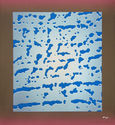
19th, 20th & 21st Century Fine Prints
707-546-7352 · fax 707-546-7924 · web: www.annexgalleries.com · email: artannex@aol.com
June Claire Wayne Biography
June Claire Wayne
American
1918–2011
Biography
June Claire Wayne, painter, printmaker, educator, and administrator, was born in Chicago, Illinois on 7 March 1918. She was primarily self-taught as an artist and had her first exhibition at the Boulevard Bookshop in Chicago in 1934 at age seventeen.
The following year her first major exhibition was mounted at the Palacio de Bellas Artes in Mexico City. Wayne moved to New York City in 1939, where she worked in the garment industry, an endeavor that continued to inform her work throughout her career. With the advent of World War II, she traveled to California where she studied technical drawing at the California Institute of Technology in Pasadena. After a brief return to Chicago where she worked in the WPA program and wrote for a radio station, she moved to Los Angeles in 1946.
In 1948, Wayne attended Lynton Kistler's lithography classes in Los Angeles, working in his studio on numerous occasions. Dissatisfied with the limitations of the workshop, Wayne traveled to Paris in 1957 to work with Marcel Durassier, hoping to find the encouragement to funnel her vision of experimental fine art lithography into a reality. Working with master printers and fine paper made it apparent that a comparable workshop was needed in the United States. She consulted with artist Clinton Adams in 1959 and, with a grant from the Ford Foundation, the Tamarind Lithography Workshop was founded in Los Angeles in 1960. Adams served as the founding associate director and Wayne served as its director. After ten years of co-operating the workshop, she arranged to hand over the workshop to the University of New Mexico, Albuquerque, where it remains a magnet for artists from all over the world.
Wayne then explored large-scale tapestry production at the historic Manufactory des Gobelins in Paris. After creating designs for tapestries, Wayne worked directly with the weavers at the factory, unlike many artists of the time who left their projects in the hands of the institute. She also focused on oil painting and sculpture, and often explored physics and astronomy in her subject matter. She continued to work in color lithography and often pared down her editions to focus on perfecting her technique.
June Wayne's experiences as a woman in the Modern art world made it obvious to her that there was a need for representation and support for women in the arts. Despite her outright rejection of the label “woman artist,” she created a forum to instruct female artists how to self-promote. In 1972, Wayne held her first seminar for aspiring women artists, curators, and directors hoping to bolster their knowledge in navigating galleries, museums, universities and other institutions; these events would eventually become known as the “Joan of Art” seminars.
Wayne is ensured a niche in the history of lithography with her prolific and pioneering body of work, as well as, the Tamarind Institute. She has been honored with numerous accolades and her affiliations included memberships in the National Association of Women Artists, Society of American Graphic Artists, Philadelphia Print Club, Los Angeles Art Association, and the Society of Washington Printmakers. She participated in thousands of exhibitions in the United States and internationally. Her work is represented in numerous collections of which include the Los Angeles County Museum of Art and the University of Southern California, Los Angeles; the Museum of Modern Art, New York; the Bibliothèque Nationale de France, Paris; the Fine Arts Museums of San Francisco, California; and the Library of Congress, Washington, D.C.
June Wayne died at her home in Los Angeles on August 23, 2011.







